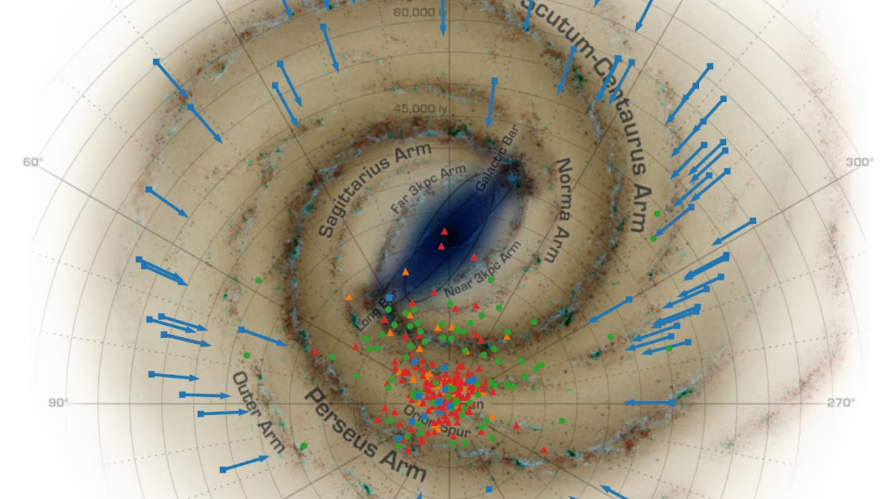
The Fermi gamma-ray space telescope has discovered around 300 rapidly spinning neutron stars. Each of the newfound objects sweep two beams of radiation across the universe like a cosmic lighthouse.
These neutron stars are known to spin hundreds of times per second and are specifically called millisecond pulsars; prior to the launch of Fermi in 2008, humanity was aware of less than ten examples of such bodies. They're particularly of note because they blast out a form of high energy electromagnetic radiation known as gamma-rays. Moreover, within this clutch of never-before-seen neutron stars are several so-called "spider pulsars," which are believed to devour their companion stars (any stars locked in orbit with them) like black widow spiders devour their mates.
"We have been very excited about how many millisecond pulsars we have been able to detect using these gamma rays," Naval Research Laboratory astrophysicist Matthew Kerr said in a statement. "These high-speed millisecond pulsars are now some of nature’s most precise timekeepers."
By "timekeepers," Kerr is referring to how the precise periodic rotation of millisecond pulsars means they can be used as timing mechanisms for deep space events. They effectively serve as cosmic clocks, exhibiting what are known as "pulsar timing arrays."
Related: Mysterious blasts of radiation might stem from our universe’s most extreme stars
Like all neutron stars, rapidly spinning millisecond pulsars are born when massive stars reach the end of their fuel supply used for nuclear fusion. This puts a stop to energy flowing out from the cores of stars — energy that has helped supported them from the inward force of their own gravity for billions of years.
The outer material of these dying stars then gets blown away in a massive supernova explosion while their cores, which have masses between one and two times that of the sun, are crushed down to the width of around 12 miles (20 kilometers). In the wake of the star's destruction, a neutron star is sometimes born.
The original star's size-reduction generates the extreme characteristics we find in neutron stars, like neutron-rich matter so dense a tablespoon of it would weigh 1 billion tons on Earth; magnetic fields so intense they blast out beams of gamma-rays Fermi can detect as periodic pulses. The rapid reduction in diameter also speeds up the neutron star's spin, akin to an ice skater drawing in their arms to twirl faster.
As they age, neutron stars slow down. In turn, their magnetic fields weaken, and they start to spin slower. Yet, when these exotic dead stars exist in a binary system, they are capable of getting a second wind.
"We are able to study these objects that began as young pulsars in a binary system," Kerr said. "Like a spinning top, they eventually slowed down and became inert. Over the past hundreds of millions of years, their binary companions dumped matter onto them, causing their speed to increase again, very dramatically and far faster than before, 'recycling' these pulsars into millisecond pulsars."

Hunting cosmic spiders
One fascinating aspect of these new pulsar discoveries is the fact many of them are "spider pulsars." These neutron stars are named as such because, like post-copulation black widows, they devour their binary companion stars.
"Spider pulsars are named after arachnids that eat their smaller mates," Megan DeCesar, discovery team member and a scientist at George Mason University, said in the statement. "Something similar can happen when a neutron star and its binary companion are very close to each other, and the millisecond pulsar 'recycling' process gets a little carried away.
"The intense radiation and particle wind from the pulsar eats away at the surface of the other star, resulting in a puffball of evaporated material."
Fermi is better at spotting these spider pulsars than other radio telescopes because radio waves from the neutron stars are sometimes blocked when pulsar beams pass over the remains of devoured stars. High-energy gamma rays (Fermi's specialty) are however capable of penetrating the stellar wreckage.
"While it may be that spider systems are also intrinsically brighter in gamma rays, studying them will help us to understand their origins and the bonanza of discoveries we have made with Fermi," said DeCesar.
How to use a cosmic clock
One recent example of millisecond pulsars being used as precise cosmic clocks was with the measurement of tiny time fluctuations caused by the passage of low-frequency gravitational waves — tiny ripples in spacetime launched by distant black hole mergers and neutron star collisions.
"These are such exciting results," Thankful Cromartie, National Research Council Research Associate at the Naval Research Laboratory ,said in the statement. "These low-frequency gravitational waves allow us to peer into the centers of massive galaxies and better understand how they were formed."
Pulsar timing arrays could also be used in the future for navigation purposes, with rapidly spinning neutron stars playing the role of cosmic GPS systems for guidance beyond the surface of Earth. To do this, however, researchers will need to constrain the stability of such pulsars, something this discovery could help with.
A paper about the 300 new neutron stars was published on Nov. 27 in the Astrophysical Journal.







